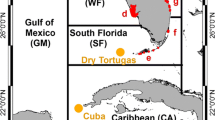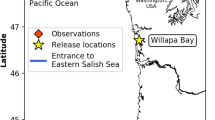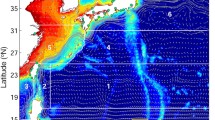Abstract
Larval transport between Johnston Atoll and the Hawaiian Archipelago was examined using computer simulation and high-resolution ocean current data. The effects of pelagic larval duration and spawning seasonality on long-distance transport and local retention were examined using a Lagrangian, individual-based approach. Retention around Johnston Atoll appeared to be low, and there appeared to be seasonal effects on both retention and dispersal. Potential larval transport corridors between Johnston Atoll and the Hawaiian Archipelago were charted. One corridor connects Johnston Atoll with the middle portion of the Hawaiian Archipelago in the vicinity of French Frigate Shoals. Another corridor connects Johnston Atoll with the lower inhabited islands in the vicinity of Kauai. Transport appears to be related to the subtropical countercurrent and the Hawaiian Lee countercurrent, both located to the west of the archipelago and flowing to the east. A new analytical tool, termed CONREC–IRC is presented for the quantification of spatial patterns.










Similar content being viewed by others
References
Boehlert GW, Watson W, Sun LC (1992) Horizontal and vertical distributions of larval fishes around an isolated oceanic island in the tropical Pacific. Deep-Sea Res 39:439–466
Bourke P (1987) CONREC: a contouring subroutine. Byte June 1987:143–150
Bradbury IR, Snelgrove PVR (2001) Contrasting larval transport in demersal fish and benthic invertebrates: the roles of behavior and advective processes in determining spatial pattern. Can J Fish Aquat Sci 58:811–823
Codling EA, Hill NA, Pitchford JW, Simpson SD (2004) Random walk models for the movement and recruitment of reef fish larvae. Mar Ecol-Prog Ser 279:215–224
Dytham C (2003) How landscapes affect the evolution of dispersal behaviour in reef fishes: results from an individual-based model. J Fish Biol 63:213–225
Fisher R (2005) Swimming speeds of larval coral reef fishes: impacts on self-recruitment and dispersal. Mar Ecol-Prog Ser 285:223–232
Fisher R, Wilson SK (2004) Maximum sustainable swimming speeds of nine species of late stage larval reef fishes. J Exp Mar Biol Ecol 312:171–186
Gilmartin M, Revelante N (1974) The island mass effect on the phytoplankton and primary production of the Hawaiian Islands. J Exp Mar Biol Ecol 16:181–204
Grigg RW (1981) Acropora in Hawaii. Part II. Zoogeography. Pac Sci 35:15–24
Grigg RW, Wells J, Wallace C (1981) Acropora in Hawaii. Part 1. History of the scientific record, systematics and ecology. Pac Sci 35:1–13
Harrison PL, Babcock RC, Bull GD, Oliver JK, Wallace CC, Willis BL (1984) Mass spawning in tropical reef corals. Science 223:1186–1189
Hooke R, Jeeves TA (1961) Direct search solution of numerical and statistical problems. J Assoc Comp Mach 8:212–229
Jokiel PL (1989) Rafting of corals and other organisms at Kwajalein Atoll. Mar Biol 101:483–493
Kenyon JC (1992) Sexual reproduction in Hawaiian Acropora. Coral Reefs 11:37–43
Kingsford MJ, Leis JM, Shanks A, Lindeman KC, Morgan SG, Pineda J (2002) Sensory environments, larval abilities and local self-recruitment. B Mar Sci 70:309–340
Kosaki RK, Pyle RL, Randall JE, Irons DK (1991) New records of fishes from Johnston Atoll, with notes on biogeography. Pac Sci 45:186–203
Leis JM (1983) Coral reef fish larvae (Labridae) in the East Pacific Barrier. Copeia 1983(3):826–828
Leis JM, Lee K (1994) Larval development in the lutjanid subfamily Etelinae (Pisces): The genera Aphareus, Aprion, Etelis and Pristipomoides. B Mar Sci 55:46–125
Lobel PS (1997) Comparative settlement age of Damselfish larvae (Plectroglyphidodon imparipennis, Pomacentridae) from Hawaii and Johnston Atoll. Biol Bull 193:281–283
Lobel PS (2003) Marine life of Johnston Atoll, Central Pacific Ocean. Natural World Press, Vida
Maragos JE, Potts DC, Aeby GA, Gulko D, Kenyon J, Siciliano D, VanRavenswaay D (2004) 2000–2002 Rapid ecological assessment of corals (Anthozoa) on shallow reefs of the Northwestern Hawaiian Islands. Part 1: species and distribution. Pac Sci 58:211–230
Mundy BC (2005) Checklist of fishes of the Hawaiian Archipelago. Bishop Museum Press, Honolulu
Palacios DM (2004) Seasonal patterns of sea-surface temperature and ocean color around the Galápagos: regional and local influences. Deep-Sea Res 51:43–57
Polovina JJ, Mitchum GT (1992) Variability in spiny lobster Panulirus marginatus in the Northwestern Hawaiian Islands. Fish Bull Natl Oc At 90:483–493
Polovina JJ, Kleiber P, Kobayashi DR (1999) Application of TOPEX-POSEIDON satellite altimetry to simulate transport dynamics of larvae of spiny lobster, Panulirus marginatus, in the Northwestern Hawaiian Islands, 1993–1996. Fish Bull Natl Oc At 97:132–143
Qiu B, Koh D, Lumpkin C, Flament P (1997) Existence and formation mechanism of the North Hawaiian Ridge Current. J Phys Oceanogr 27:431–444
Rhodes RC, Hurlburt HE, Wallcraft AJ, Barron CN, Martin PJ, Metzger EJ, Shriver JF, Ko DS, Smedstad OM, Cross SL, Kara AB (2002) Navy real-time global modeling systems. Oceanography 15:29–43
Riginos C, Victor BC (2001) Larval spatial distributions and other early life-history characteristics predict genetic differentiation in eastern Pacific blennioid fishes. P Roy Soc Lond B Bio 268:1931–1936
Rivera MAJ, Kelley CD, Roderick GK (2004) Subtle population genetic structure in the Hawaiian grouper, Epinephelus quernus (Serranidae) as revealed by mitochondrial DNA analyses. Biol J Linn Soc 81:449–468
Robertson DR, Grove JS, McCosker JE (2004) Tropical transpacific shore fishes. Pac Sci 58:507–565
Smith WHF, Sandwell DT (1997) Global sea floor topography from satellite altimetry and ship depth soundings. Science 277:1956–1962
Springer VG (1982) Pacific plate biogeography with special reference to shorefishes. Smithson Contrib Zool 367:1–182
Victor BC (1986) Delayed metamorphosis with reduced larval growth in a coral reef fish, Thalassoma bifasciatum. Can J Fish Aquat Sci 43:208–13
Wallcraft AJ, Kara AB, Hurlburt HE, Rochford PA (2003) NRL Layered Ocean Model (NLOM) with an embedded mixed layer sub-model: formulation and tuning. J Atmos Ocean Tech 20:1601–1615
Walsh WJ (1987) Patterns of recruitment and spawning in Hawaiian reef fishes Environ Biol Fish 18:257–276
Xie SP, Liu WT, Liu Q, Nonaka M (2001) Far-reaching effects of the Hawaiian Islands on the Pacific Ocean-Atmosphere System. Science 292:2057–2060
Yoshida K, Kidokoro T (1967) A subtropical countercurrent (II). A prediction of eastward flows at lower subtropical latitudes. J Oceanogr Soc Jpn 23:231–246
Acknowledgements
I thank Jeffrey Polovina, Evan Howell, David Booth, and Will Figueira for their constructive comments on earlier versions of the manuscript. NLOM data was acquired with the capable assistance of Dr. James Potemra of the International Pacific Research Center, SOEST, University of Hawaii.
Author information
Authors and Affiliations
Corresponding author
Additional information
Communicated by Ecology Editor P.J. Mumby
Appendix
Appendix
CONREC–IRC (IRC refers to “Iterative Region of Containment”) is an iterative program to objectively enclose a scatter of cartesian data points at a user-defined level of containment using a standard contouring algorithm to define the polygon. It was developed from CONREC, an open-source contouring subroutine originally written in FORTRAN-77 (Bourke 1987). CONREC has been ported to many languages (see http://www.astronomy.swin.edu.au/∼pbourke/projection/conrec/), including the Visual Basic version (by James Craig), which was the precursor to CONREC–IRC. CONREC–IRC is written in QuickBasic 4.5 and takes advantage of the POINT command, which can query an individual pixel on the graphical output screen. This functionality was instrumental to CONREC–IRC by enabling tabulation of raw data points inside or outside of the contoured polygon. While mathematical algorithms exist to determine whether a point is within a polygon or not, the simplest method of plotting points, plotting the enclosing polygon, filling the enclosing polygon with color, then querying each data point’s color was the most straightforward technique. The basic step-by-step methodology of CONREC–IRC is as follows:
Because only a single value is being optimized, a simple, direct search algorithm (Hooke and Jeeves 1961) was used to converge on the contouring level that would encompass the specified amount of data points. Proportional adjustments to the contour value were based on residuals from the percentage of data points encompassed. Testing with simulated data indicated that CONREC–IRC was able to quickly find the contouring solution within 10–15 iterations and was not sensitive to starting values. CONREC–IRC is suited for spatial data with a single center of mass with density tapers in all directions. More complex spatial patterns would yield multiple or nested contours and are not amenable to the CONREC–IRC approach since definition of a single mass is problematic. The source code for CONREC–IRC is available on request.
Rights and permissions
About this article
Cite this article
Kobayashi, D.R. Colonization of the Hawaiian Archipelago via Johnston Atoll: a characterization of oceanographic transport corridors for pelagic larvae using computer simulation. Coral Reefs 25, 407–417 (2006). https://doi.org/10.1007/s00338-006-0118-5
Received:
Accepted:
Published:
Issue Date:
DOI: https://doi.org/10.1007/s00338-006-0118-5






